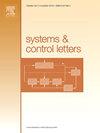连续时间风险规避最优控制的梯度下降-上升方法
IF 2.5
3区 计算机科学
Q3 AUTOMATION & CONTROL SYSTEMS
引用次数: 0
摘要
本文考虑连续时间随机最优控制问题,其中成本是通过一个一致的风险度量来评估的。我们提供了一个显式梯度下降-上升算法,适用于非线性随机微分方程问题。更具体地说,我们利用相干风险测度的对偶性,通过在最大子问题中引入人工强凹性的光滑最小-最大重构来松弛问题。然后,我们为这个松弛问题制定了必要的最优性条件,我们利用它来证明梯度下降-上升算法对原始问题的候选解的收敛性。最后,我们通过涉及轨迹跟踪问题的数值模拟展示了我们算法的效率,并强调了偏好风险度量而不是经典期望的好处。本文章由计算机程序翻译,如有差异,请以英文原文为准。
A gradient descent-ascent method for continuous-time risk-averse optimal control
In this paper, we consider continuous-time stochastic optimal control problems where the cost is evaluated through a coherent risk measure. We provide an explicit gradient descent-ascent algorithm that applies to problems subject to non-linear stochastic differential equations. More specifically, we leverage duality properties of coherent risk measures to relax the problem via a smooth min–max reformulation which induces artificial strong concavity in the max subproblem. We then formulate necessary optimality conditions for this relaxed problem, which we leverage to prove convergence of the gradient descent-ascent algorithm to candidate solutions of the original problem. Finally, we showcase the efficiency of our algorithm through numerical simulations involving trajectory tracking problems and highlight the benefit of favoring risk measures over classical expectations.
求助全文
通过发布文献求助,成功后即可免费获取论文全文。
去求助
来源期刊

Systems & Control Letters
工程技术-运筹学与管理科学
CiteScore
4.60
自引率
3.80%
发文量
144
审稿时长
6 months
期刊介绍:
Founded in 1981 by two of the pre-eminent control theorists, Roger Brockett and Jan Willems, Systems & Control Letters is one of the leading journals in the field of control theory. The aim of the journal is to allow dissemination of relatively concise but highly original contributions whose high initial quality enables a relatively rapid review process. All aspects of the fields of systems and control are covered, especially mathematically-oriented and theoretical papers that have a clear relevance to engineering, physical and biological sciences, and even economics. Application-oriented papers with sophisticated and rigorous mathematical elements are also welcome.
 求助内容:
求助内容: 应助结果提醒方式:
应助结果提醒方式:


